Ciqikou Ancient Town is located on the banks of the Jialing River in Shapingba District, Chongqing. It is a national 4A-level tourist attraction and a famous historical and cultural street in China. The ancient town was founded in the Song Dynasty and has a unique landform of "one river, two streams, three mountains and four streets", covering an area of about 1.5 square kilometers, with a core protected area of 0.7 square kilometers. Its characteristic is that it preserves 12 mountainous ancient streets with the style of the Ming and Qing dynasties. The buildings are mainly Sichuan-Chongqing dwellings, mostly with blue tiles, white walls and brick-wood structures. The layout of the streets and lanes is in a "T" shape. Most of the existing ancient buildings were built from the Ming and Qing dynasties to the Republic of China. The ancient town integrates Bayu culture, religious culture, Shaci culture, Hongyan culture and folk culture, and is known as "Little Chongqing".
Historical Culture
Ciqikou was anciently called "Baiyanchang" because Zhu Yunwen, the Jianwen Emperor, lived in seclusion here and inscribed the word "Baiyan". It became a porcelain production center in the Song Dynasty. By the Ming and Qing dynasties, due to the developed shipping on the Jialing River, it became a material distribution center in the eastern Sichuan region. The name "Ciqikou" replaced the old name because of the prosperity of the porcelain industry.
During the Anti-Japanese War, Ciqikou became an important rear area of Chongqing, the temporary capital. Institutions such as National Central University and Chongqing University moved here. Cultural celebrities such as Xu Beihong and Fu Baoshi once lived here, leaving a large number of cultural relics. At the same time, it is also an important carrier of Hongyan culture, and the New Fourth Army's Chongqing Office was located in the ancient town.
The ancient town retains traditional folk culture, such as Sichuan opera sit-singing, fire dragon performances, and night watchmen. Among them, "Ciqikou Fire Dragon" has been included in the list of intangible cultural heritage in Chongqing. The fire dragon lantern festival held every Spring Festival attracts tens of thousands of tourists.
Main Attractions
Cizheng Street
Cizheng Street is the main street of the ancient town, with a total length of 1278 meters and a width of 3-5 meters. It is paved with bluestones, and on both sides are stilted buildings and shops with the style of the Ming and Qing dynasties. The street is dotted with historic sites such as Hanlin Academy, Baolun Temple, and Zhong's Courtyard. Among them, Hanlin Academy is the site of a private school in the Qing Dynasty, and the existing building is a typical quadrangle courtyard, covering an area of about 800 square meters.
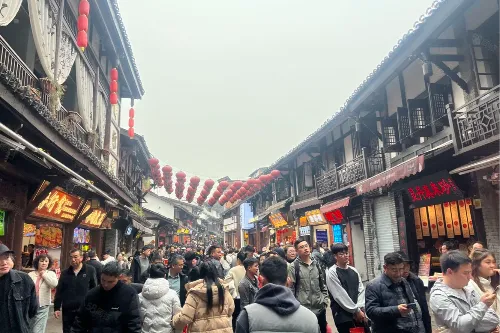
Baolun Temple
Baolun Temple was founded during the Zhenguan period of the Tang Dynasty, with a history of more than 1400 years. It is one of the oldest temples in Chongqing. The temple is located on Jinbi Mountain in Ciqikou, with a construction area of about 3000 square meters. It preserves buildings such as the Mahavira Hall of the Ming Dynasty and the Scripture Repository of the Qing Dynasty. The wooden structure of the Mahavira Hall adopts full mortise and tenon technology without using a single nail.
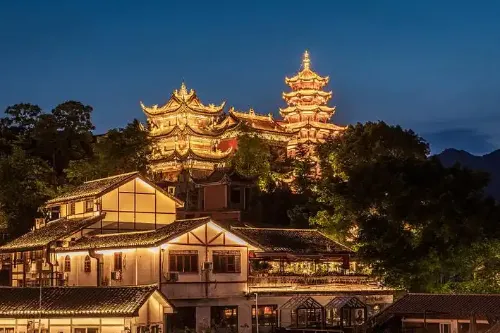
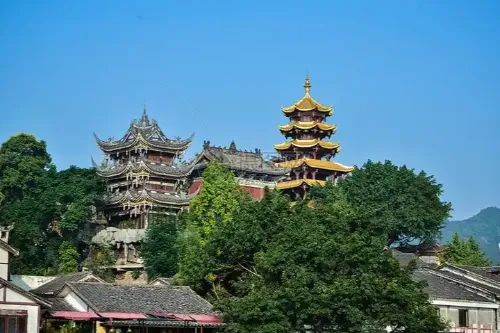
Zhong's Courtyard
Zhong's Courtyard is a residential courtyard from the late Qing Dynasty to the early Republic of China. It was originally the residence of Zhong Yunting, a wealthy merchant in Ciqikou, covering an area of about 1500 square meters. The courtyard is a typical style of eastern Sichuan dwellings, consisting of main rooms, side rooms and a courtyard. It preserves carved doors and windows, bluestone courtyard and other features, showing the architectural art of traditional dwellings.
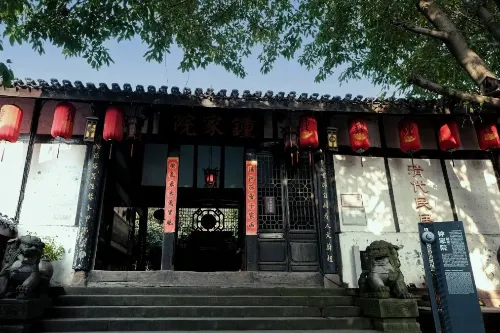
Hanlin Academy
Originally named Lishi Cottage, also known as Lishi School, it is one of the only remaining ancient private schools in the main urban area of Chongqing. During the Qianlong period of the Qing Dynasty, the Sun family ran a school here, cultivating many Juren (successful candidates in the provincial imperial examination) and Jinshi (successful candidates in the national imperial examination). Therefore, there is a saying here that "three Juren in one family, two Hanlin scholars within five li". Now, Hanlin Academy has been converted into a teahouse.

Wenchang Palace
Wenchang Palace was founded in the Ming Dynasty as a place to worship Wenchang Emperor, covering an area of about 1200 square meters. The existing building was rebuilt in the Qing Dynasty. The palace has Wenchang Hall, Kuixing Pavilion, etc., with exquisite architectural decorations and exquisite wood and stone carvings. Historically, Wenchang Palace was a place for local scholars to pray for academic success. Now it has become an important venue for displaying the folk culture of the ancient town, often holding cultural activities such as calligraphy and painting.
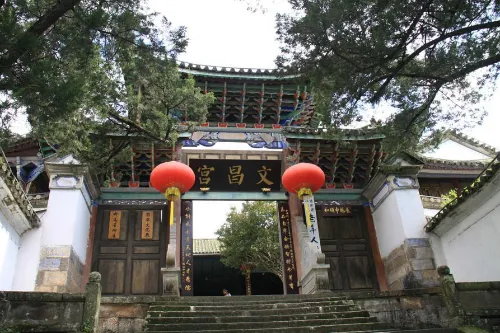
Baoshan Palace
Baoshan Palace was founded in the Qing Dynasty, initially as a Taoist temple, covering an area of about 1000 square meters. The existing building is a brick-wood structure, consisting of a front hall, a back hall and side rooms on both sides. It used to enshrine Taoist gods and is now converted into Ciqikou Folk Custom Museum, displaying daily necessities, costumes, festival items of the ancient town residents, systematically presenting the folk culture of the Bayu area.
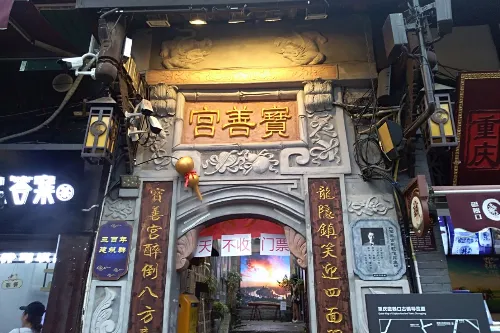
Ciqikou Wharf
Ciqikou Wharf was once an important land and water wharf on the Jialing River. The existing wharf was rebuilt in the Qing Dynasty, about 200 meters long and 15 meters wide. It retains relics such as stone steps and bollards. There is an "Old Teahouse" by the bank, where tourists can experience traditional covered-bowl tea and Sichuan opera performances.
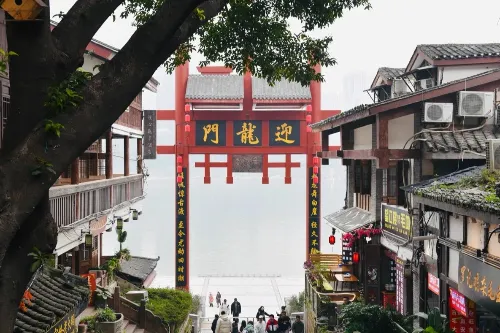
Ciqikou Back Street
Ciqikou Back Street is adjacent to the thousand-year-old Ciqikou Ancient Town, with a total area of 83,700 square meters, a planned construction area of about 154,000 square meters, and a total investment of about 1.8 billion yuan. It runs through three cultural themes: climbing the mountain city, visiting old streets, and tasting creativity, in the form of "centralized commercial center + open independent blocks". It retains three ancient buildings left over from the Ming and Qing dynasties, continuing the historical context of Ciqikou.
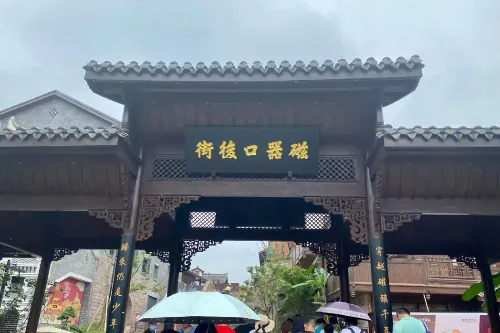
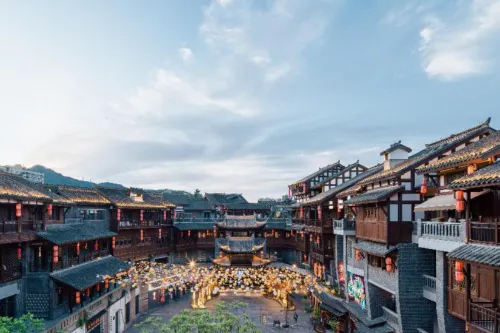
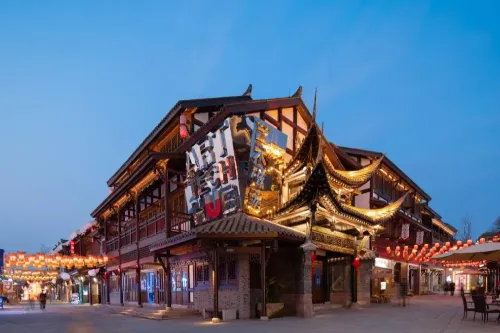
Tour Route
Recommended route: Arrive at the ancient town at 9:30 am, enter Cizheng Street from the main gate, visit Hanlin Academy (30 minutes) → walk to Baolun Temple (1 hour), climb Jinbi Mountain to overlook the panoramic view of the ancient town; have lunch at Cizheng Street, tasting Maoxuewang (spicy blood curd) or Chen's twisted dough sticks; visit Zhong's Courtyard in the afternoon (40 minutes) → stroll to Ciqikou Wharf (30 minutes), experience covered-bowl tea in the old teahouse; enjoy the sunset over the Jialing River by the river in the evening to end the trip.
Transportation
- Metro: Take Metro Line 1 to Ciqikou Station, exit from Exit 1, and walk for 5 minutes to reach the entrance of the ancient town.
- Bus: Take bus No. 202, 220, 237, 503, etc. to Ciqikou Station and get off.
- Self-driving: Navigate to "Ciqikou Ancient Town Parking Lot". Depart from downtown Chongqing, take the Inner Ring Expressway to Shaci Avenue, with a driving time of about 30 minutes. The parking lot charges about 5-10 yuan per hour.
Travel Suggestions
- The best season to visit is spring and autumn (March-May, September-November), when the temperature is pleasant, with an average temperature of 15-22℃, suitable for outdoor activities; the temperature is higher in summer (average 28-35℃), so pay attention to heatstroke prevention.
- It is recommended to spend half a day to a day here. If you only visit the main attractions, 3-4 hours are enough; if you want to experience folk activities or stay overnight, you can arrange one day and one night.
- There are many bluestone roads in the ancient town, and some sections have large slopes. It is recommended to wear comfortable flat shoes, with a daily walking distance of about 3-4 kilometers.
- There are many tourists on weekends and holidays, so it is recommended to visit during off-peak hours.
- For snacks like Chen's twisted dough sticks, you can compare products from multiple stores, and some stores offer free samples; it is more cost-effective to buy souvenirs at stores on the edge of the ancient town.
- The temperature in the ancient town is relatively high in summer, so pay attention to heatstroke prevention and cooling, and you can bring a small fan; the wind by the river is strong in winter, so you need to prepare a windproof coat.
- It is recommended to experience the old teahouse at "Baoshan Palace", with a consumption of about 20-30 yuan per person, where you can watch Sichuan opera face-changing, lantern rolling and other performances.
- During the Spring Festival every year (the first day to the fifteenth day of the first lunar month), the ancient town holds a temple fair with dragon and lion dances, Sichuan opera performances and other activities. You can visit at this time if you are interested.
Matters Needing Attention
- When visiting religious places such as Baolun Temple, keep quiet, respect religious customs, and do not make loud noises or take photos.
- Self-driving tourists should pay attention to the parking lot signs to avoid entering one-way streets; the parking lot is easily saturated on holidays, so it is recommended to arrive early or choose public transportation.
- Some sections of the ancient town have insufficient lighting at night. Be careful when visiting in the evening and go in groups.
- There are many people in the ancient town, so take good care of your personal belongings, especially valuables such as mobile phones and wallets, and guard against pickpockets.
- Some special snacks are spicy. If you have a sensitive stomach, you can tell the merchant in advance to reduce the amount of chili.
- Smoking is prohibited in the ancient town. There are special smoking areas, which must be strictly observed to avoid fire.
- The bluestone roads are slippery on rainy days, so walk slowly and pay attention to safety; take sun protection measures in summer, such as bringing a sun hat and sunscreen.
- Some sections in the ancient town are narrow. Avoid using scooters, balance bikes and other means of transportation to avoid colliding with others.
- Respect the lives of local residents, do not enter private courtyards at will, and ask for permission before taking photos of others.
- There are multiple public toilets and rest areas in the scenic area, which can be found according to the signs. Please keep the environment clean.
Opening Hours
The ancient town is open all day. The business hours of shops on the main street are generally 09:00-22:00, and the opening hours of small attractions are 09:30-18:00 (winter) to 19:00 (summer).
Tickets
Ciqikou Ancient Town is open for free. Some small attractions such as Zhong's Courtyard and Baolun Temple require separate tickets: Zhong's Courtyard is 10 yuan per person, and Baolun Temple is 5 yuan per person.
Online Booking
Click here to jump to the Trip.com ticketing platform for ticket purchase.


